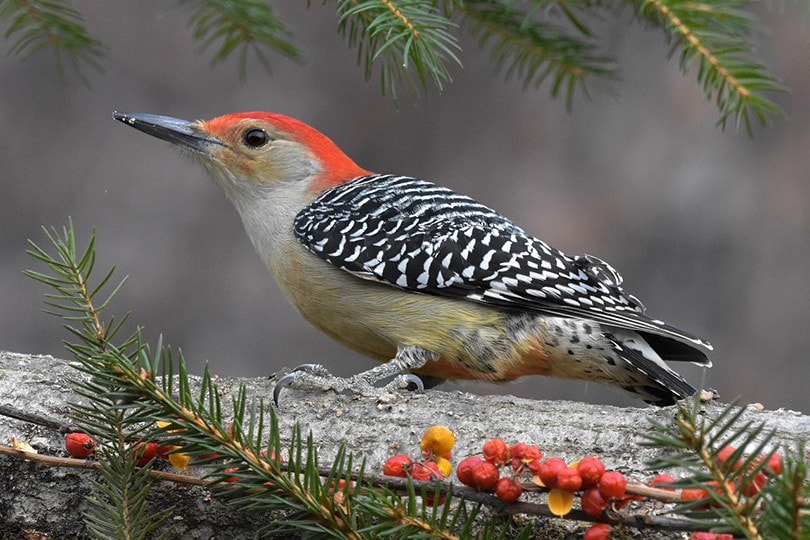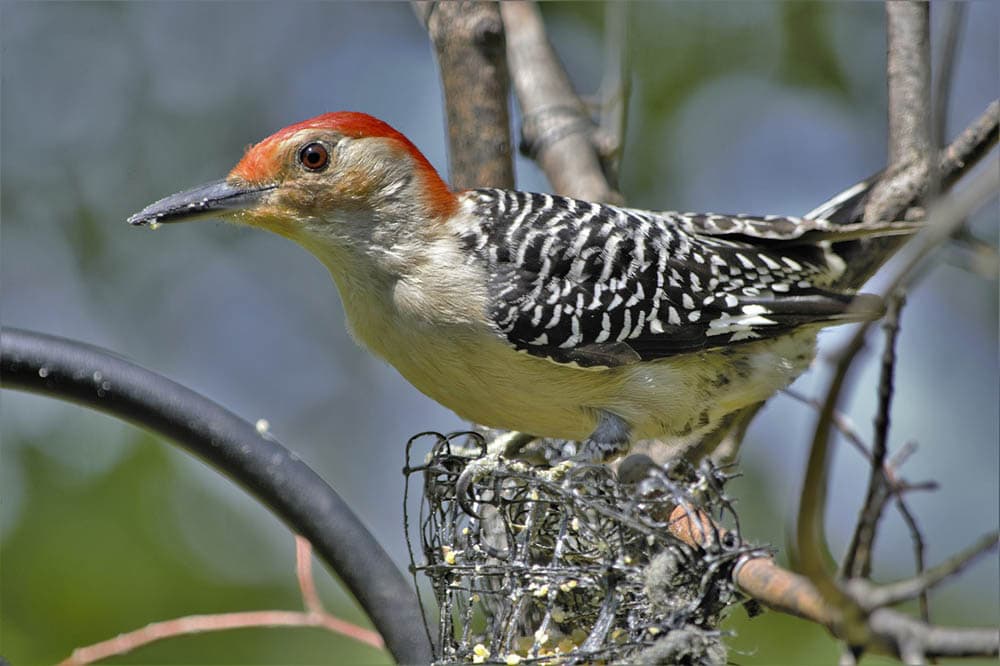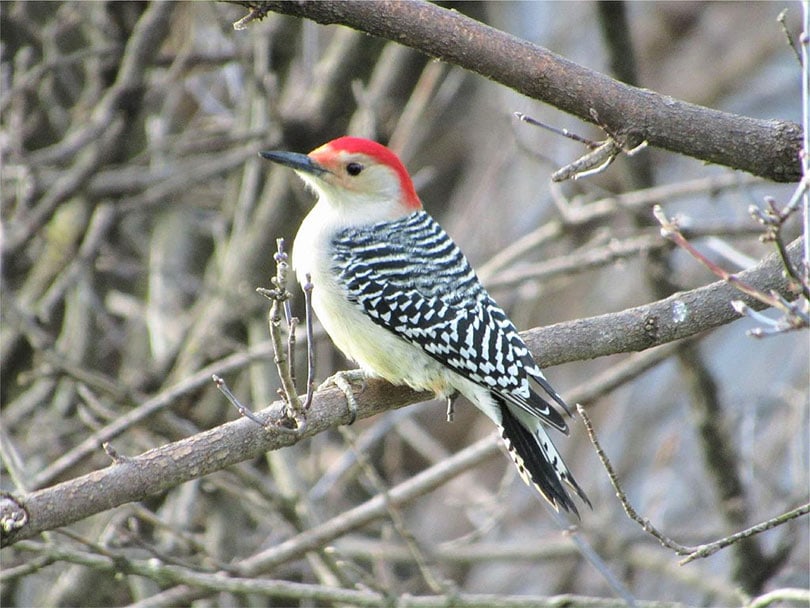Red-Bellied Woodpecker: Field Guide, Pictures, Habitat & Info
Last Updated on

Woodpeckers are some of the most fascinating birds to watch. Of the various woodpecker species, one favorite is the Red-Bellied Woodpecker. This woodpecker has a distinctive look that is impossible to miss and breathtaking to behold.
Of course, you have to know what this woodpecker looks like, when to look, and what to look for. If you don’t know this information, you might not even realize that you have a stunning Red-Bellied Woodpecker in your yard.
Keep reading for a comprehensive field guide concerning Red-Bellied Woodpecker watching. This includes pictures, habitat, and general info about this unique breed.

Quick Facts about the Red-Bellied Woodpecker

| Habitat: | Woodlands, groves, deciduous forests, orchards, towns |
| Diet: | Omnivorous |
| Behavior: | Forage on tree trunks and limbs |
| Nesting: | Antagonist displays when defending territory; nests in excavated dead wood |
| Conservation: | Least concern with numbers increasing |
| Scientific name: | Melanerpes carolinus |
| Lifespan: | 10 years |
Red-Bellied Woodpecker General Description
Red-Bellied Woodpeckers are known for their distinctive black and white patterned back. They also have a bright red head, but this head sometimes appears more orange on females. Oddly enough, their bellies are more of a white color, not red.
Like many other woodpeckers, Red-Bellied individuals have a chiseled shape bill. This bill allows the woodpecker to drill into tree trunks and limbs to get at the insects nested below the bark. The bill is a black or gray color.
As for size, Red-Bellied Woodpeckers are medium-sized birds. Adults weigh about 72.5 grams and are between 22.9–26.7 inches long. Their wingspan is 38–46 centimeters, though. Males tend to be between 8%–9% larger than females on average.
Red-Bellied Woodpecker Range, Habitat, Behavior, Diet & Nesting

Range
Red-Bellied Woodpeckers are found year-round in the eastern and middle United States. Although these birds sometimes perform local movements to follow food, these birds are not truly migratory.
Habitat
Red-Bellied Woodpeckers prefer deciduous forests, especially those found along rivers and swamps. Sometimes, you will find them mixed into coniferous forests as well, but they’re not commonly found in forests with pure pine mixes.
Sometimes, you can find this bird in open areas, but this typically occurs next to forest edges, clearings, groves, and woodlands.
Behavior
Red-Bellied Woodpeckers are often seen foraging for insects on tree trunks and limbs. They like to climb up the branch and perch. If you look closely enough, you can even see them catch insects flying through the air. They will sometimes pick berries and nuts, which they often store in bark crevices for the winter.
Diet
These woodpeckers are considered insectivorous. They eat many insects, but they often eat a lot of plant material, such as acorns, nuts, berries, fruits, and seeds. In some seasons, Red-Bellied Woodpeckers actually eat more plant material than insects. On occasion, these birds eat tree frogs, eggs, and small fish, too.
Nesting
Red-Bellied woodpeckers use antagonistic displays to defend their territory. Some common displays include spreading wings, raising head feathers, and slow floating flight. Often, you will find nest sites in excavated wood cavities, such as on a tree, fence post, or stump.
The males begin excavating, and they often make multiple holes for the female to choose from. Once the eggs are hatched, there are typically four to five, and they are white. Both sexes incubate the eggs and feed the young. The parents will even continue feeding their young for as much as 6 weeks or more after leaving the nest.

How to Find the Red-Bellied Woodpecker: Birdwatching Tips

Because Red-Bellied Woodpeckers have such a distinctive look, they are relatively easy to identify. Nevertheless, here are some tips for how to find a Red-Bellied Woodpecker in your area:
What to Listen For
Red-Bellied Woodpeckers are not particularly known for their song. They have a shrill, rolling “kwirr” sound that both sexes use. Occasionally, you can hear a coughing “cha cha cha” sound or a throaty growl whenever mates are calling to one another.
What to Look For
The easiest way to find a Red-Bellied Woodpecker is to look for them around your yard. Their distinctive black and white back feathers are hard to miss. If you see the black and white feathers paired with a redhead, you know you found a Red-Bellied Woodpecker.
When to Look
Unlike other bird species, winter is actually one of the best times to see a Red-Bellied Woodpecker up close. These birds are not migratory, which means they will remain in your area even in the winter months. Whenever it is cold, it is easy to entice these birds to your yard and see them due to the lack of leaves.
Attracting the Red-Bellied Woodpecker to Your Backyard: Tips & Tricks
Woodpeckers as a whole are not as easy to attract to your backyard simply because the available trees and wildlife are largely what attracts them. Nevertheless, there are ways that you can attract Red-Bellied Woodpeckers to your yard.
First, make sure you have deciduous wooden patches around your yard. If you don’t have any deciduous trees, it’s going to be next to impossible to attract Red-Bellied Woodpeckers. With deciduous trees in your area, this will make the task of attracting the woodpeckers easier.
Second, set up bird feeders near the edges of the woody sections. In the winter, fill bird feeders with suet, peanuts, and seeds. In the summer, stick to seeds and nuts, but don’t use suet. Occasionally, woodpeckers are attracted to Hummingbird feeders as well.
Red-Bellied Woodpecker Conservation: Is this Bird Threatened?
For a brief period during the early 1900s, Red-Bellied Woodpeckers were declining in numbers. Luckily, this is not the case anymore. Red-Bellied Woodpeckers are considered to be of “least concern” in terms of conservation, and their numbers are slightly increasing, though the population is generally stable.

Conclusion
If you live in the Eastern United States and have deciduous trees in your area, keep an eye out for Red-Bellied Woodpeckers. More specifically, look for their black and white backs with red heads. Once you see one, you will know exactly what kind of bird you are looking for.
Unfortunately, you are unlikely to see a Red-Bellied Woodpecker in other areas of the United States. Even so, definitely know what these birds look and sound like so that you can keep your eyes open on your travels.
Featured Image Credit: JackBulmer, Pixabay
Table of Contents
- Quick Facts about the Red-Bellied Woodpecker
- Red-Bellied Woodpecker General Description
- Red-Bellied Woodpecker Range, Habitat, Behavior, Diet & Nesting
- How to Find the Red-Bellied Woodpecker: Birdwatching Tips
- Attracting the Red-Bellied Woodpecker to Your Backyard: Tips & Tricks
- Red-Bellied Woodpecker Conservation: Is this Bird Threatened?
- Conclusion
About the Author Robert Sparks
Robert’s obsession with all things optical started early in life, when his optician father would bring home prototypes for Robert to play with. Nowadays, Robert is dedicated to helping others find the right optics for their needs. His hobbies include astronomy, astrophysics, and model building. Originally from Newark, NJ, he resides in Santa Fe, New Mexico, where the nighttime skies are filled with glittering stars.
Related Articles:
Binocular Magnification Chart: Numbers & Distances Compared
10 Types of Hummingbirds in Arkansas (With Pictures)
8 Types of Hummingbirds in Nebraska (With Pictures)
5 Types of Hummingbirds in Idaho (With Pictures)
3 Types of Hummingbirds in Mississippi (With Pictures)
8 Types of Hummingbirds in Kansas (With Pictures)
5 Types of Hummingbirds in West Virginia (With Pictures)
5 Types of Hummingbirds in Ohio (With Pictures)
